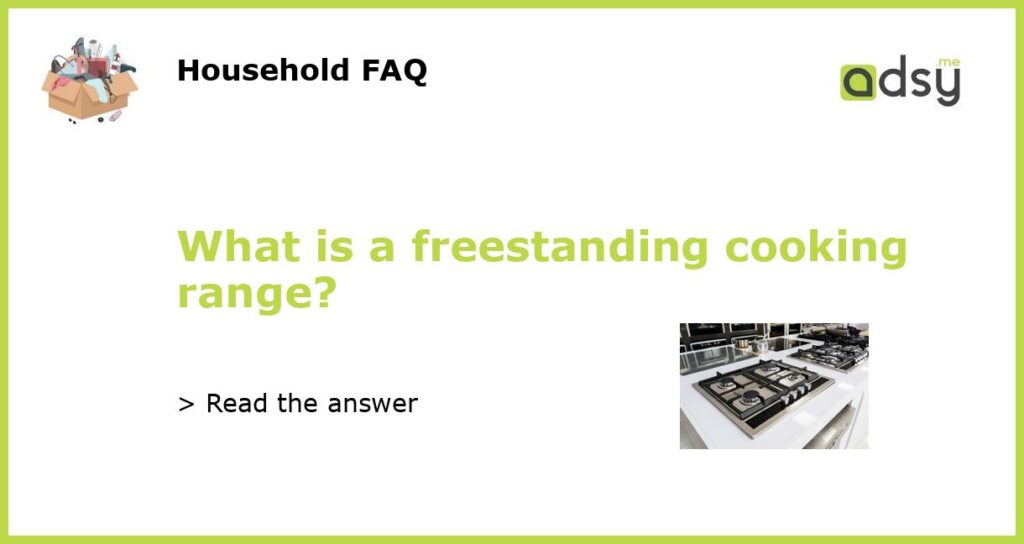What is a Freestanding Cooking Range?
A freestanding cooking range, also known as a stove, is a cooking appliance that combines a cooktop and an oven in one unit. It is an essential appliance in the kitchen and a focal point of the room, both in terms of function and design. A freestanding cooking range can come in various sizes, styles, and fuel types, ranging from compact electric models to large professional gas ranges.
Types of Freestanding Cooking Ranges
There are three main types of freestanding cooking ranges, based on their fuel source:
- Gas Range: Uses natural gas or propane as fuel and is preferred by many professional chefs and cooking enthusiasts for its precise temperature control and instant heat.
- Electric Range: Uses electricity as fuel and is preferred by those who want easier maintenance and cleaning, more even heat distribution, and safety features such as a smooth ceramic cooktop and a self-cleaning oven.
- Dual Fuel Range: Uses both gas and electricity, typically featuring a gas cooktop and an electric oven, and provides the best of both worlds in terms of cooking performance and versatility.
Features of Freestanding Cooking Ranges
Depending on the brand, model, and price range, a freestanding cooking range can have various features and options that improve its functionality, convenience, and style. Here are some common features of freestanding cooking ranges:
- Cooktop Elements: The number and type of burners or elements, their size and power, and their configuration (e.g. bridge element, warming zone, griddle) can affect the cooktop’s versatility and performance.
- Oven Capacity: The size of the oven cavity, measured in cubic feet, can determine how much food you can bake or roast at once.
- Oven Functions: The type and number of oven functions, such as convection, broil, self-clean, and delay-start, can affect the oven’s versatility and convenience.
- Control Panel: The location, visibility, and ease of use of the control panel can affect your cooking experience, especially if you have specific preferences or disabilities.
- Design: The style, finish, and accessories of the cooking range can affect its visual appeal and compatibility with your kitchen decor.
How to Choose a Freestanding Cooking Range
Choosing a freestanding cooking range can be overwhelming, considering the variety of options available and the complexity of your cooking needs and preferences. Here are some factors to consider when choosing a freestanding cooking range:
- Fuel Type: Consider your fuel availability and preferences, as well as the performance and maintenance costs of each fuel type.
- Cooking Style: Consider your cooking frequency, style, and skill level, as well as the types of dishes you like to prepare and the cookware you use.
- Kitchen Layout: Consider your kitchen size, layout, and ventilation, as well as the placement and clearance of the cooking range.
- Budget: Consider your budget range and the features and styles that matter to you the most, and try to balance them with your cooking needs and long-term value.
- Brand and Warranty: Consider the reputation and reliability of the brand, as well as the warranty and customer support options.
Caring for Your Freestanding Cooking Range
Once you have chosen and installed your freestanding cooking range, it is important to take proper care of it to ensure its longevity, safety, and performance. Here are some tips for caring for your freestanding cooking range:
- Clean Regulary: Clean the cooktop and oven regularly with mild detergent and water or specialized cleaners, depending on the type of surface and stains.
- Avoid Overheating: Do not exceed the recommended temperature and duration for each cooking method, and avoid putting excess weight or pressure on the cooktop or oven door.
- Use Proper Cookware: Use cookware that matches the size and type of burner or heating element, and avoid using metal objects or abrasive cleaners that can damage the cooktop or oven interior.
- Seek Professional Repair: If you notice any malfunctions, strange noises, or gas leaks, seek professional repair from a trusted and certified technician.
- Read the Manual: Read the user manual and follow the instructions and safety guidelines carefully, and keep the manual handy for future reference.






